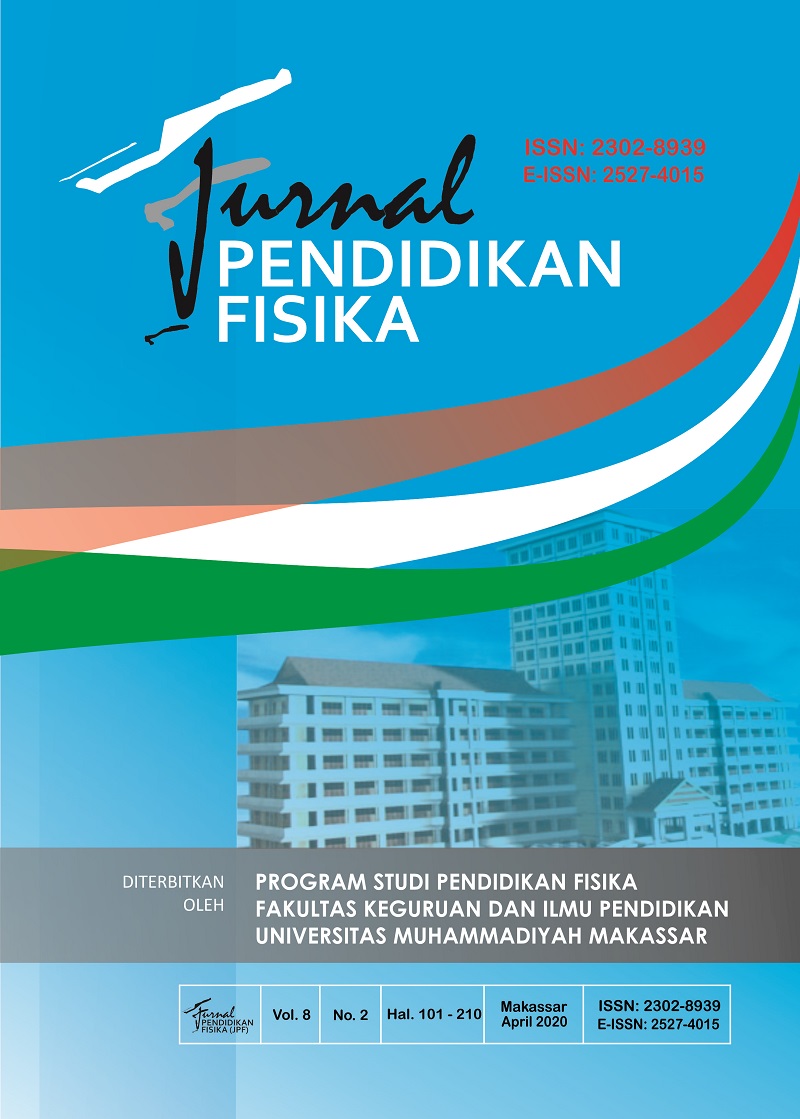The Models of Physical Intuition Students use Phenomenological Elements in Solving Physics Problems
DOI:
https://doi.org/10.26618/jpf.v8i2.3352Keywords:
Models, Intuitions, Pemecahan Masalah, Thinking-Aloud, InterviewsAbstract
This research applied qualitative research which used descriptive method in order to analyze the use of intuition physics of students in solving physics problems. This research was conducted at SMA Al Azhar Palu. The subjects of this research are nine students, they are divided by three categories which are the high, middle and low categories. The average value obtained from the respondents' test results was 43,46 and the standard deviation was 21,71. Respondents with a high category are respondents who are above the value of 65,17. The instruments of the research used are the respondent selection test, analyzing the use of intuition physics and interview guidance. Data were collected through thinking-aloud activities, which of respondents do a test then write the answers on a paper while expressing matters related to what was written and recorded that using a handycame. Interviews were conducted as supporting data in analyzing the results of thinking-aloud. Based on the analysis of data, it is obtained by the model of intuitions physics which contains the p-prims. It consists of cuing priority, reliability priority and the conclusion.The use of appropriate physics intuition is useful to help students apply their mathematical skills in solving physics problems. The proper physics intuition model is through all stages of the p-prims elements obtained through student learning experiences related to physics. It is necessary to develop learning that considers the importance of using physics intuition as a performance framework for evaluating the progress of students' problem solving processes better and more productively.
References
Aryal, B. (2006). Use of Physical Models to Facilitate Transfer of Physics Learning to Understand Positron Emission Tomography. [online]. Tersedia: http://phys.ksu.edu/. [25 juli 2015].
Bing, T. and Redish, E. (2007). The Cognitive Blending of Mathematics and Physics Knowledge. In Proceedings of The Physics Education Research Conference, Syracuse, NY, August 2006. AIP Conf. Proc 883 : 26-29.
Bramley, N.R., Gerstenberg, T., Tenenbaum, J.B. and Gureckis, T.M. (2018). Intuitive experimentation in the physical world. https://doi.org/10.1016/j.cogpsych.2018.05.001. [18 April 2020].
Buteler, L. and Coleoni, E. (2014). Exploring The Relation Between Intuitive Physics Knowledge and Equestions During Problem Solving. Electronic Journal of Science education 18 (2): 1-20.
Choi, J.W and Yoon, S. (2019). Intrinsic Motivation Driven Intuitive Physics Learning using Deep Reinforcement Learning with Intrinsic Reward Normalization https://arxiv.org/abs/1907.03116. [18 April 2020].
Gette, C. R. and Kryjevskaia, M. (2019). Establishing a relationship between student cognitive reflection skills and performance on physics questions that elicit strong intuitive responses :15(1). https://link.aps.org/doi/10.1103/PhysRevPhysEducRes.15.010118. [18 April 2020].
diSessa, A. (1993). Epistemology Toward an Epistemology of Physics. EBSCOHost EJS. Cognition and Instruction 10(2): 105-225.
Galili, I. and Hazan, A. (2000). The influence of an Historically Oriented Course of Students’ Content Knowledge in Optics Evaluated by Means of Facets-Schemes Analysis. American Journal of Physics 68 (7): S3-S15.
Hu, D. and Rebello, N. (2013). Using Conceptual Blending to describe How Students Use Mathematical Integrals in physics. Physical Review Special Topics-Physics Education Research. 9.2.
Moleong, L.J. (1991). Metode Penelitian Kualitatif. Penerbit Remaja Rosda Karya. Bandung
Park, M. (2020). Students’ problem-solving strategies in qualitative physics questions in a simulation-based formative assessment: 2(1) https://doi.org/10.1186/s43031-019-0019-4 [18 April 2020].
Nazir, M. (2003). Metode Penelitian. PT Ghalia Indonesia. Jakarta.
Nasution. (2004). Metode Research. Bumi Aksara. Jakarta.
Nurwulandari, N., Alam, Y. dan Ajeng, R.S. (2019). Pengaruh Pengetahuan Intuitif terhadap Kemampuan Pemecahan Masalah pada Pembelajaran Fisika Materi Hukum Archimedes. http://journal.unublitar.ac.id/pendidikan/index.php/Riset_Konseptual. JP: 3(4)
Singh, C. (2016) When Physical Intuition Fails. https://arxiv.org/abs/1602.06637 [18 April 2020].
Zeev, T. and Star, J. (2002). Intuitive Mathematics: Theoretical and Educational Implicationsns.Undestanding and teaching the Understanding and teaching the Intuitive Mind: Student and Teacher Learning. University of Michigan. 29-56.
Downloads
Published
Issue
Section
License
Copyright:
Authors who publish with this journal agree to the following terms:
1. Authors retain copyright and grant the journal right of first publication with the work simultaneously licensed under a Creative Commons Attribution-ShareAlike 4.0 International License that allows others to share the work with an acknowledgement of the work's authorship and initial publication in this journal.
2. Authors are able to enter into separate, additional contractual arrangements for the non-exclusive distribution of the journal's published version of the work (e.g., post it to an institutional repository or publish it in a book), with an acknowledgement of its initial publication in this journal.
3. Authors are permitted and encouraged to post their work online (e.g., in institutional repositories or on their website) prior to and during the submission process, as it can lead to productive exchanges, as well as earlier and greater citation of published work.
Licence:
Authors are free to:
1. Share: Copy and redistribute the material in any medium or format
2. Adapt: Remix, transform, and build upon the material for any purpose, even commercially.
The licensor cannot revoke these freedoms as long as the authors follow the license terms, which include the following:
1. Attribution: You must give appropriate credit, provide a link to the license, and indicate if changes were made. You may do so in any reasonable manner, but not in any way that suggests the licensor endorses you or your use.
2. ShareAlike: If you remix, transform, or build upon the material, you must distribute your contributions under the same license as the original.
3. No additional restrictions: You may not apply legal terms or technological measures that legally restrict others from doing anything the license permits.
Jurnal Pendidikan Fisika is licensed under a Creative Commons Attribution-ShareAlike 4.0 International License.

